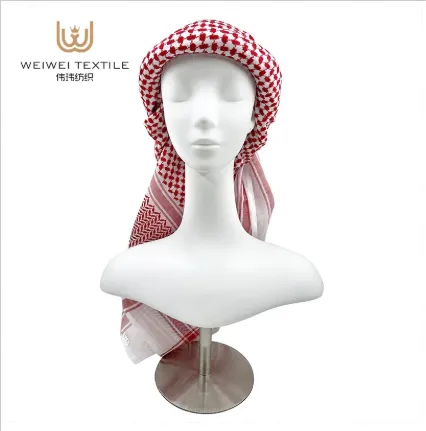Jan . 23, 2025 11:44 Back to list
The Shemagh: A Symbol of Tradition, Style, And Function
The shemagh, also known by various names like yashmagh and keffiyeh, is a versatile and iconic piece of clothing widely worn in the Middle East and beyond. This traditional headwear is not only a symbol of cultural identity but also a practical accessory, providing protection against the sun, dust, and cold. In this article, we explore the different variations of the shemagh, including the Yemeni shemagh, Saudi shemagh, Arabic shemagh, and the popular shemagh for men.

Yemeni Shemagh: A Distinctive Style from Yemen
The Yemeni shemagh, or yashmagh, is known for its unique design and vibrant colors. While it shares similarities with other regional headscarves, the Yemeni shemagh often features intricate patterns and a heavier weave, providing more substantial protection against the elements. This version is particularly popular in Yemen and the surrounding Gulf states, where it is often worn by men as part of formal and traditional attire. The shemagh’s durability and functionality make it an essential part of daily life in these regions, especially in harsh desert climates.
Saudi Shemagh: Classic and Timeless
The Saudi shemagh is perhaps one of the most recognizable types of shemagh. Known for its iconic red-and-white checkered design, it is widely worn in Saudi Arabia and the surrounding Gulf nations. The Saudi shemagh is an essential piece of attire for many men, often paired with a ghutra (headpiece) or igal (headband) to secure the scarf in place. Its lightweight fabric is perfect for protecting against the intense heat of the desert, making it both a functional and fashionable choice.
In Saudi Arabia, wearing a shemagh is a symbol of cultural pride and tradition. It is often seen at formal events, weddings, and daily social interactions, where it represents respect for heritage and style.
Arabic Shemagh: A Cultural Icon Across the Middle East
The Arabic shemagh is worn across the Arab world and holds significant cultural meaning. While the design and color schemes may vary from country to country, the shemagh remains an essential part of Arab heritage. Typically, it is worn by men, and its practical uses include providing shade from the sun, warmth in colder weather, and protection against sand and dust storms.
The shemagh is not just a functional garment; it also represents unity and identity among Arabic-speaking communities. In addition to its widespread use in everyday life, it is also an important symbol at cultural events, celebrations, and public demonstrations.
Shemagh for Men: Versatility in Fashion and Function
Today, the shemagh has transcended its traditional roots, becoming a popular fashion accessory for men worldwide. With its functional attributes and stylish designs, it can be worn in a variety of ways—draped over the shoulders, wrapped around the neck, or placed as a head covering. Whether worn for protection or as a statement of personal style, the shemagh remains a symbol of masculinity, elegance, and cultural pride.
The shemagh is more than just a headscarf—it’s a symbol of tradition, identity, and utility. Whether it’s the vibrant Yemeni shemagh, the classic Saudi version, or the iconic Arabic shemagh, this piece of clothing continues to be an essential and fashionable choice for men around the world. Embracing its rich history and practicality, the shemagh is a timeless accessory that connects generations and cultures.
-
Traditional Tudung Designs in Malaysia
NewsJul.25,2025
-
The Spiritual Significance of Satin in Muslim Attire
NewsJul.25,2025
-
The Right Way to Wear Arab Scarves for Muslim Women
NewsJul.25,2025
-
Zikr Bead-Infused Cotton Voile for Continuous Remembrance
NewsJul.11,2025
-
The Cultural Significance of Tudung in Malaysia
NewsJul.11,2025
-
Satin Hijabs as an Expression of Faith in Daily Life
NewsJul.11,2025














